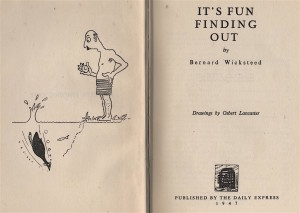Discovered in a box of books is this copy of It’s Fun Finding Out, putatively by Bernard Wicksteed, but actually written with Chapman Pincher, the man who was to become a true legend among spy-hunters.
Back in 1947, when the book was published by the Daily Express, Wicksteed, an RAF war hero, was an ex sub-editor who had published his first book, Father’s Heinkel in 1944. Pincher was an ex physics teacher who had recently joined the Express as a science correspondent. One day Express editor Arthur Christiansen had the bright idea of bringing the two men together to compile an exploration of weird facts something along the lines of the American Ripley Believe It Or Not books. The result was It’s Fun Finding Out.
Structured so as to reveal facts while on visits to several places, including a Zoo, the seaside, a farm, a wood at night, a river bank, the country in Autumn, a grouse moor, an art gallery and the Science Museum, the book also considers facts relating to social history, philately, the amazing physical toughness of Winston Churchill, the French view of the English and vice versa, and guppies, among many other topics.
As they discourse both writers cannot help revealing facts about themselves. For instance, we discover that Wicksteed went to Bedales School with Tate Gallery Director ‘ Johnny’ Rothenstein, who called him ‘Toad’, that his father Joseph Wicksteed wrote a book on Blake and that he is a bit of an aeroplane nerd. We find fewer facts about Pincher’s early life, but a lot about his extensive knowledge of most branches of science. The following, for instance, were unknown to me:
- That because cows cannot access nutritious food in winter months the milk they produce at this time lacks the important nutrients that can be found in summer milk.
- That elm trees suffer from something called ‘crotch weakness ‘, which is caused by air pockets in the joints. Some of these are as big as an egg and when there are several near together the limb is liable to split off without warning.
- That every weeping ash tree in the world is descended from a single ‘freak’ tree at Wimpole, Cambridgeshire.
- That the red on a robin’s breast will rub off.
- That because flies would be weighed down if they landed on a pond to take in water, they never do so, preferring to drink from thin films of moisture, such as can be found on a sweating brow
- That the hard roe of a barbel is very dangerous to eat and in somecases where this fish is eaten there is a complaint known as Barbel Cholera.
• That pigs are fond of eating coal and are fed it by breeders.
- That foxes and badgers often live in the same hole together.
- That hillsides are the best places to grow fruit trees.
- That in a thunderstorm lightning flashes form nitrates in the air and these come down in the rain and get washed into the ground as fertilizer.
It’s Fun finding Out proved so popular that a second series was published in 1950. However, in Abebooks only one other title bearing the name of Bernard Wicksteed is listed as appearing after this date—and this is a doubtful item. In contrast, Chapman Pincher went on to truly great things as a defence correspondent, initially with the Daily Express .Specialising in espionage, he filed so many stories that embarrassed the Ministry of Defence and the Foreign Office that Prime Minister Harold Macmillan asked if there was any way in which he could be silenced. After retiring from newspaper journalism he turned to writing books and almost up to his death in 2014 at the age of 100 he continued to rake up scoops. [R.M.Healey]


enjoyed reading this book in my early youth, (am now 59), pleased to see my recollection of author and content were correct, I think it sparked off a lifetime interest in little – known facts, thanks for the site, pete
I’d say this book more than any other sparked my lifelong interest in science, and influences my work to this day as a science songwriter, and the way I work with children when I lead science songwriting workshops in both the UK and USA. I’m the world’s first Songwriter-in-residence with a science festival ( Cambridge, Massachusetts since 2007) , andi have been profiled in New Scientist magazine. And it all started with this remarkably engaging, inspiring and informative book. This is science as it should be taught in primary schools.